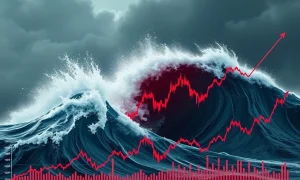In recent months, the financial world has keenly observed the **USD/EUR** currency pair. This pair, representing the US dollar’s value against the euro, is among the most actively traded globally. Market observers at Seekapa have noted an unusually tight movement in the USD/EUR. This trend is drawing considerable interest from traders and analysts alike. But why is this happening? And what does this stability mean for CFD traders and the broader forex market? Let’s explore these critical questions.
Understanding the USD/EUR Phenomenon
The **USD/EUR** pair stands as a cornerstone of the global foreign exchange market. It reflects the economic health and monetary policies of the world’s two largest economies: the United States and the Eurozone. Its sheer volume and deep liquidity make it a benchmark for international trade and investment. Therefore, even minor shifts in this pair can have significant ripple effects. Recently, however, the USD/EUR has exhibited a remarkable period of relative calm. This calm contrasts sharply with the volatility seen in other major currency pairs. Analysts from Seekapa highlight this unusual stability as a key point of focus. Indeed, many professional traders watch the USD/EUR closely for underlying market sentiment.
Compared to many other currency pairs, the USD/EUR has remained notably stable. Over the past few months, its price has largely stayed within a narrow range. Other pairs, like GBP/JPY or AUD/USD, have experienced larger swings. These swings often result from interest rate changes or significant economic news. Yet, the USD/EUR has maintained a fairly steady course. This low volatility does not diminish its importance. On the contrary, its stability makes it a preferred choice for certain trading strategies.
Economic Factors Driving USD/EUR Stability
The current stability in the **USD/EUR** can be attributed to several converging economic factors. According to experts at Seekapa, similar economic trends in the US and the Eurozone play a crucial role. Both regions have seen a deceleration in inflation rates. Consequently, their respective central banks are adopting cautious approaches to future monetary policy adjustments. This synchronized economic posture reduces the likelihood of sharp currency movements. For instance, if one central bank were aggressively hiking rates while the other cut them, the pair would likely experience significant volatility. However, both the Federal Reserve and the European Central Bank are navigating similar economic landscapes.
Key economic indicators provide further insight. Both economies face similar challenges, including managing inflation and fostering sustainable growth. This alignment means that major economic data releases, such as inflation reports or employment figures, often elicit similar reactions in both regions. As a result, the currency pair lacks a strong impetus to move sharply in one particular direction. This situation fosters a sense of equilibrium. Traders, therefore, find fewer immediate catalysts for dramatic price swings in the **USD/EUR** market.
Navigating the USD/EUR Market with CFDs
CFDs, or Contracts for Difference, offer a flexible way to speculate on price movements without owning the underlying asset. With CFD trading, you can go long (buy) or short (sell), depending on your market outlook. When a pair like **USD/EUR** moves within a tight range, it presents unique opportunities for CFD traders. For example, traders might employ strategies focused on capturing small price fluctuations. They could also take advantage of predictable patterns within the established range.
Seekapa analysts observe that this kind of market behavior can help some traders build experience. It allows them to refine their strategies without the sudden spikes seen in more volatile pairs. This environment is particularly beneficial for those new to the forex market. However, stability also brings its own set of challenges. In a tight market, profit margins can be smaller. Therefore, traders must execute their strategies with precision. The need for robust **risk management** remains paramount. Small price movements require careful leverage and position sizing to maximize potential gains while minimizing losses. Experienced traders often appreciate the consistent, albeit smaller, opportunities that a stable **USD/EUR** market provides.
USD/EUR Compared to Other Major Pairs
When compared to more exotic or minor pairs, the **USD/EUR** stands out for its exceptional liquidity and widespread popularity. Exotic pairs, such as USD/TRY (US Dollar/Turkish Lira) or EUR/ZAR (Euro/South African Rand), typically exhibit larger price movements. These pairs are often influenced by localized news or specific political events. Such factors can lead to unexpected and rapid price jumps. Furthermore, major pairs like GBP/USD (British Pound/US Dollar) or USD/JPY (US Dollar/Japanese Yen) have also shown increased volatility recently. This volatility stems from significant political changes in the UK and Japan’s evolving monetary policy stance.
In this broader context, the **USD/EUR** truly appears as the calm in the storm. Its relative steadiness has undeniably captured the attention of many traders seeking more predictable market conditions. As Seekapa experts explain, even a quiet currency pair holds significant value for observation. Patterns may emerge slowly, but they can still provide crucial insights into broader global economic trends. The high liquidity of the USD/EUR also ensures efficient trade execution, which is vital for all types of traders. Ultimately, understanding the reasons behind a pair’s movement is key to successful trading.
Future Outlook for the USD/EUR Pair
While the **USD/EUR** has shown remarkable stability, this does not imply a permanent state of affairs. Financial markets are dynamic, and future economic data releases or shifts in central bank rhetoric could introduce new volatility. Traders should remain vigilant for potential catalysts. Key events to watch include:
- **Inflation reports**
- **Employment figures**
- **GDP growth data** from both the US and the Eurozone.
Any significant divergence in these indicators could prompt a reaction from central banks, leading to increased movement in the USD/EUR.
Moreover, global geopolitical events or unexpected economic shocks can always influence currency valuations. Therefore, continuous monitoring and adaptation are essential for traders involved with the **USD/EUR**. Seekapa analysts continue to provide in-depth reviews of the pair’s performance. Their insights help traders understand the nuances of this crucial market. Ultimately, even calm waters require careful navigation. The USD/EUR may not be the most exciting pair at present, but its foundational role in global finance ensures its continued importance for all market participants.
Frequently Asked Questions (FAQs)
Q1: Why is the USD/EUR currency pair so important?
A1: The USD/EUR is important because it represents the two largest economies globally, the US and the Eurozone. Its high liquidity and significant trading volume make it a benchmark for international trade, investment, and a key indicator of global economic sentiment.
Q2: What does it mean for the USD/EUR to be in a ‘tight range’?
A2: A ‘tight range’ means the USD/EUR’s price has remained within a narrow band over a period. This indicates low volatility, often due to similar economic conditions or cautious central bank policies in both regions, leading to less dramatic price swings.
Q3: How does the stability of USD/EUR affect CFD traders?
A3: Stability in the USD/EUR offers unique opportunities for CFD traders, particularly those who prefer strategies like scalping or range trading. It allows for more measured approaches and can be beneficial for building experience, though profit margins might be smaller, emphasizing the need for strong risk management.
Q4: How do Seekapa analysts view the USD/EUR’s performance?
A4: Seekapa analysts view the USD/EUR’s recent performance as unusually stable. They attribute this to converging economic trends and cautious central bank actions in the US and Eurozone. They emphasize that even quiet pairs provide valuable insights into broader economic trends.
Q5: What factors could cause the USD/EUR to become more volatile?
A5: The USD/EUR could become more volatile due to significant divergences in economic data (e.g., inflation, employment, GDP) between the US and Eurozone, shifts in central bank monetary policies, or major global geopolitical events and economic shocks.








